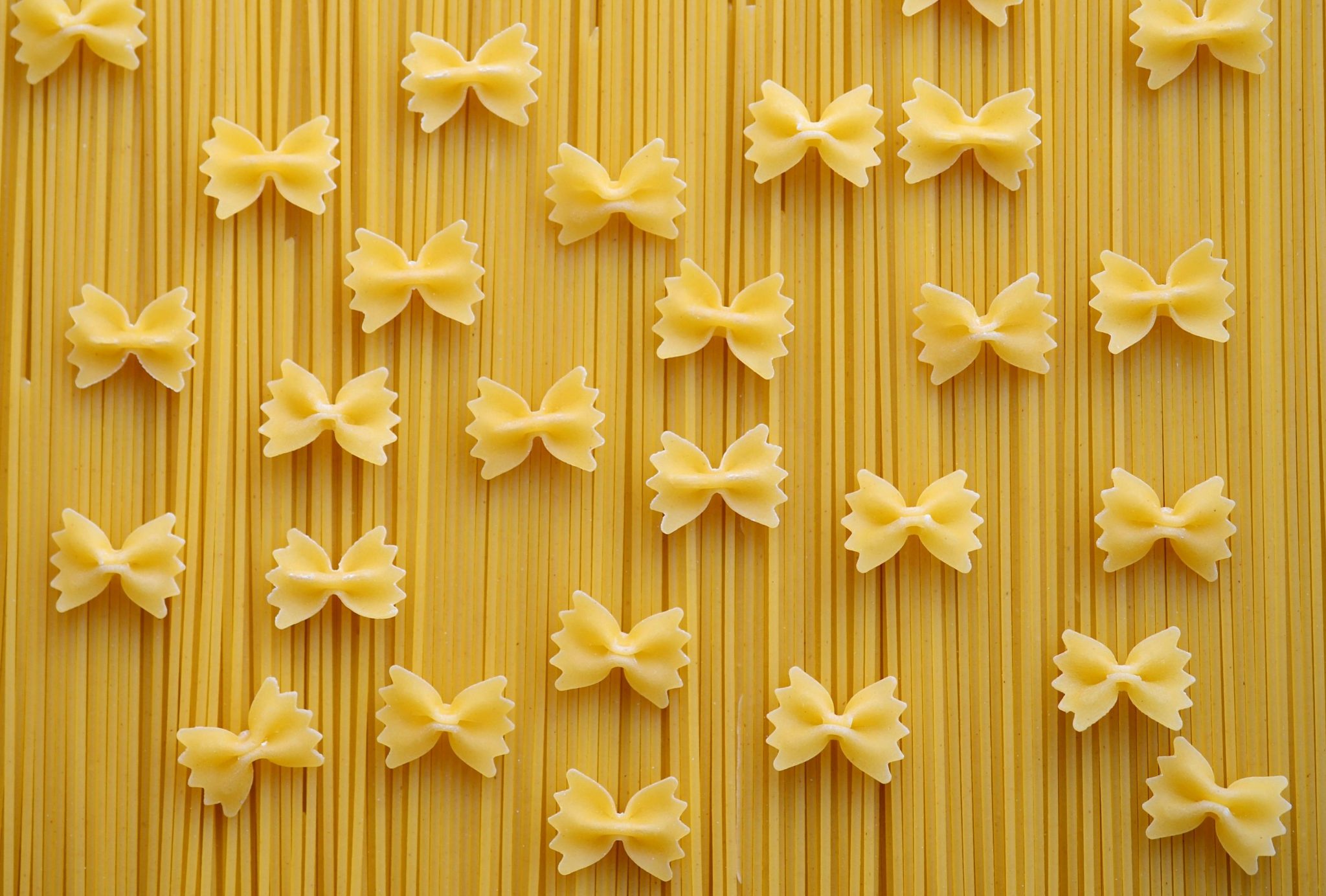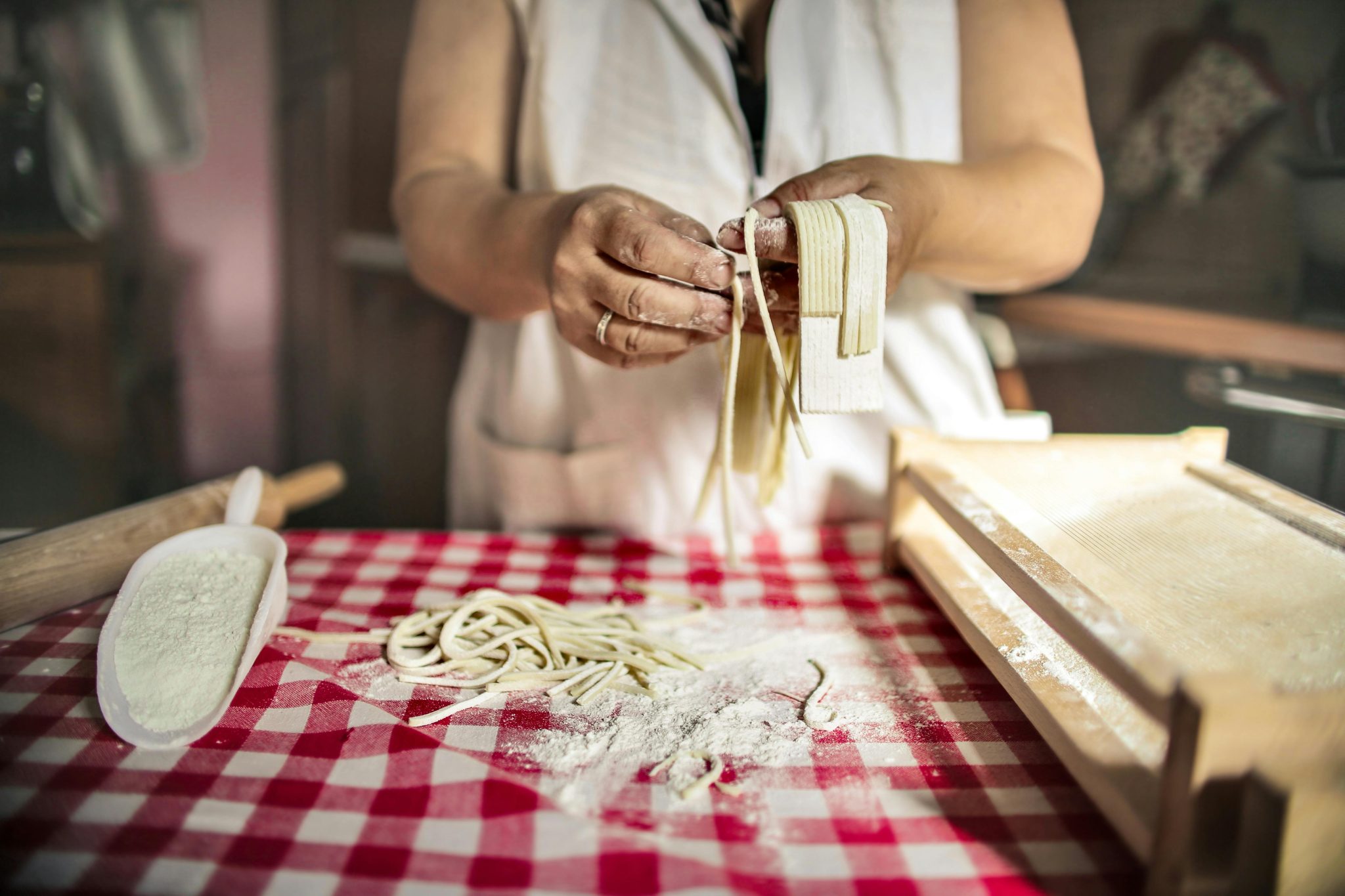When you close your eyes and picture “Italian food,” what comes to mind? For most Americans, it’s a familiar, comforting scene: a red-and-white checkered tablecloth, a basket of garlic bread glistening with butter, and a heaping plate of spaghetti buried under meatballs the size of baseballs, all smothered in a thick, red sauce and a snowstorm of parmesan from a green shaker can. It’s the food of celebratory family dinners, first dates, and cozy nights in. It’s hearty, satisfying, and, in our collective consciousness, deliciously indulgent.
When you close your eyes and picture “Italian food,” what comes to mind? For most Americans, it’s a familiar, comforting scene: a red-and-white checkered tablecloth, a basket of garlic bread glistening with butter, and a heaping plate of spaghetti buried under meatballs the size of baseballs, all smothered in a thick, red sauce and a snowstorm of parmesan from a green shaker can. It’s the food of celebratory family dinners, first dates, and cozy nights in. It’s hearty, satisfying, and, in our collective consciousness, deliciously indulgent.
But what if that picture, as beloved as it is, is little more than a caricature? What if I told you that the real, everyday Italian way of eating—the one practiced for centuries in the sun-drenched hills of Tuscany, the bustling port cities of Sicily, and the fertile plains of Emilia-Romagna—is one of the most balanced, wholesome, and life-affirming culinary traditions in the world?
This isn’t about dieting or deprivation. It’s about a philosophy deeply woven into the fabric of Italian life, a philosophy built on quality, seasonality, simplicity, and the profound pleasure of eating well. It’s a lifestyle that has gifted the world not just incredible flavors, but also some of its healthiest and longest-living populations.
In this guide, we will journey beyond the clichés of the Italian-American restaurant scene. We will deconstruct the myths, explore the foundational pillars of authentic Italian cuisine, and travel through the diverse regions of Italy to uncover the true secrets of its healthy, vibrant kitchen. Forget everything you think you know. You’re about to discover the soul of Italian food, and it’s fresher, lighter, and more delicious than you ever imagined.
Deconstructing the Myth: Why We Get Italian Food All Wrong

Before we can appreciate the truth of healthy Italian eating, we have to understand how the popular perception became so distorted. The story begins not in Italy, but in the sprawling cities of the United States over a century ago.
The Italian-American Evolution: From Immigrant Kitchens to Restaurant Chains
At the turn of the 20th century, millions of Southern Italians emigrated to the United States, seeking a better life. They brought with them their recipes, their culinary traditions, and an innate understanding of how to create delicious food from humble ingredients. But in this new world, the ingredients and economic realities were vastly different.
In Italy, especially in the poorer southern regions, meat was a luxury, consumed sparingly. Meals were built around vegetables, beans, grains, and whatever the sea provided. In America, meat, cheese, and flour were suddenly abundant and affordable. To the immigrant families working hard to build a new life, this abundance was a sign of prosperity. Their cooking evolved to reflect this newfound wealth. Dishes became larger and richer. Meat, once a rare treat, became a centerpiece, giving birth to creations like spaghetti and meatballs—a dish that simply doesn’t exist in Italy. The meatballs (polpette) are a dish unto themselves, served as a second course, never on top of pasta.
Similarly, iconic dishes like Fettuccine Alfredo and Chicken Parmigiana are largely American inventions. Alfredo di Lelio did create a version of his now-famous dish in Rome, but it was a simple preparation of fresh pasta with high-quality butter and Parmigiano-Reggiano. The heavy cream-laden sauce we know today was an American adaptation, designed to be richer and more decadent. Chicken (or veal) Parmigiana is a supersized evolution of Melanzane alla Parmigiana (Eggplant Parmesan), a classic southern Italian dish. By substituting meat for eggplant and increasing the portion size, a humble vegetable dish was transformed into a heavy, calorie-laden entrée.
This evolution wasn’t wrong; it was a beautiful and delicious expression of the immigrant experience. The problem arose when these adapted, celebratory dishes came to define “Italian food” for generations of Americans, thanks in large part to the rise of restaurant chains that standardized and amplified this hearty, super-sized style of cooking. The nuanced, vegetable-forward, and regionally diverse cuisine of Italy was flattened into a single, monolithic menu of pasta, red sauce, and melted cheese.
Portion Sizes and Meal Structure: The Italian Reality
Perhaps the biggest misconception revolves around pasta. In the United States, a pasta dish is often the entire meal—a massive bowl filled to the brim. In Italy, the structure of a meal is fundamentally different and inherently more balanced. A traditional Italian dinner is a leisurely affair, often composed of several smaller courses:
-
Antipasto: A small starter, meaning “before the meal.” This could be a few olives, a slice of prosciutto with melon, or some marinated vegetables. The goal is to awaken the palate, not to fill you up.
-
Primo: The first course. This is typically where pasta, risotto, or soup is served. Crucially, the portion size is modest—often just a few ounces (around 80-100 grams) of pasta. It’s a course designed to be satisfying but leave room for what’s to come.
-
Secondo: The second course. This is the main protein of the meal, such as grilled fish, a small piece of roasted chicken, or a slice of steak. It is rarely served with a starchy side like potatoes, as the pasta course already filled that role.
-
Contorno: A side dish served alongside the secondo. This is almost always a vegetable—sautéed greens, a simple salad, roasted fennel, or stewed beans. The contorno is not an afterthought; it is an essential, balancing component of the meal.
-
Dolce: Dessert, which is often just a simple piece of fruit on a weeknight. Elaborate cakes and pastries are typically reserved for special occasions and holidays.
This structure naturally encourages moderation and variety. Instead of one massive plate of carbohydrates and fat, a traditional Italian meal provides a balanced intake of grains, protein, and plenty of vegetables. It also reflects a different attitude toward eating. The Italian table is not a fuel station; it’s a place for conversation, relaxation, and savoring each bite. The slow pace allows the body to register fullness, preventing the overeating that’s so common in our fast-paced culture. This is the essence of la dolce vita (the sweet life) at the table—a principle that is as healthy for the mind as it is for the body.
The Pillars of Authentic Italian Eating
At the heart of Italy’s truly healthy kitchen are three unwavering principles. They are not rules written in a diet book but are cultural tenets passed down through generations. Mastering them is the first step to unlocking the secrets of Italian wellness.
Pillar 1: The Quality of Ingredients
If there is one non-negotiable commandment in the Italian culinary bible, it is this: start with the best possible ingredients, and do as little as possible to them. An Italian cook’s genius lies not in complex techniques or heavy sauces, but in their ability to source pristine ingredients and allow their natural flavors to shine.
This reverence for quality is codified in a system of certifications that are fiercely protected. You may have seen labels like “DOP” or “IGP” on Italian products. These aren’t just marketing terms; they are legally binding guarantees of provenance and quality.
-
DOP (Denominazione di Origine Protetta / Protected Designation of Origin): This is the strictest certification. It guarantees that the entire product, from the raw ingredients to the final processing, originates from a specific geographical area and adheres to a precise, traditional method of production. Famous examples include Parmigiano-Reggiano DOP, Prosciutto di Parma DOP, and Aceto Balsamico Tradizionale di Modena DOP.
-
IGP (Indicazione Geografica Protetta / Protected Geographical Indication): This certification is slightly more flexible but still ensures quality. It requires that at least one phase of the production process takes place in a designated geographical region. It’s a guarantee of authenticity and a connection to place.
This system fosters a deep respect for the land and the producers. It’s the opposite of a faceless, industrialized food system. Italians know their butchers, their bakers, and the farmers at the local market. They have a relationship with their food. The concept of chilometro zero (zero-kilometer), the Italian equivalent of “farm-to-table,” isn’t a trendy slogan; it’s the traditional way of life. Shopping at the bustling local mercato is a daily or weekly ritual, a place to buy what’s fresh, what’s local, and what’s best right now. A sun-ripened San Marzano tomato, a freshly pressed extra virgin olive oil, a wedge of nutty Parmigiano-Reggiano—these aren’t just ingredients; they are expressions of a specific place and time, and they form the foundation of a truly healthy and flavorful kitchen.
Pillar 2: Seasonality
The modern American supermarket is a place of perpetual abundance. You can buy asparagus in December, tomatoes in February, and strawberries in October. For the Italian cook, this is not a luxury; it’s a tragedy. The Italian culinary clock is set by the seasons, and to eat out of season is to eat food that is devoid of flavor and spirit.
This devotion to seasonality is about more than just taste; it’s about eating in harmony with nature’s rhythm. A tomato picked from the vine in the heat of August has a sweetness and vitality that a pale, hothouse tomato in winter can never replicate. Eating seasonally ensures that fruits and vegetables are consumed at their absolute peak of nutritional value and flavor.
This philosophy shapes the entire menu of the country. Spring in Italy means tender artichokes (carciofi), fresh fava beans, and delicate asparagus. Summer is a celebration of tomatoes, eggplant, zucchini, and bell peppers. Autumn brings a bounty of mushrooms (funghi), squash (zucca), and chestnuts (castagne). Winter offers hearty greens like kale (cavolo nero), chicory, and citrus fruits.
This approach means that the food is constantly changing, offering a diverse array of nutrients throughout the year. It also fosters a sense of anticipation and appreciation. This mindful way of eating connects them to the land and provides a far richer and more varied diet than one built on the monotonous availability of a globalized food supply.
Pillar 3: Simplicity
American cooking, especially in restaurants, often strives for complexity. Dishes have long lists of ingredients, intricate sauces, and elaborate presentations. The Italian approach is the polar opposite. The goal is to strip a dish down to its essential components, creating something that is more than the sum of its parts. True Italian cooking is an exercise in elegant restraint.
Think of some of the most beloved Italian dishes. Cacio e Pepe, a Roman classic, contains just three ingredients: pasta, Pecorino Romano cheese, and black pepper. The magic is in the technique—emulsifying the cheese and pasta water into a creamy, perfect sauce. A classic bruschetta al pomodoro is nothing more than grilled bread, garlic, ripe tomatoes, fresh basil, and good olive oil. There is nothing to hide behind. If the tomatoes aren’t perfectly ripe or the olive oil is mediocre, the dish fails.
This philosophy of simplicity naturally leads to healthier food. There are no heavy, cream-based sauces to mask the flavor of the main ingredients. There are no deep-fried coatings or sugary glazes. Instead, flavor is built through simple, wholesome techniques: grilling, roasting, and sautéing. Vegetables are often served simply dressed with olive oil, lemon, and salt. Fish is grilled whole with herbs. This isn’t “diet food”; it’s just good food, prepared in a way that respects the integrity of the ingredients. By focusing on a few high-quality items, Italian cooking delivers maximum flavor with minimal fuss and a much healthier profile.
A Journey Through Italy’s Healthy Regions
Italy is a young country with an ancient culinary history. For centuries, it was a collection of city-states and kingdoms, each developing its own distinct dialect, culture, and, most importantly, cuisine. To speak of “Italian food” is like speaking of “European music”—it misses the beautiful and vast diversity within. A journey through the regional kitchens of Italy is a journey through landscapes, climates, and histories that have shaped some of the healthiest and most delicious food on the planet.
The Heart of the Mediterranean: Sicily and Southern Italy
The sun-drenched island of Sicily and the southern regions of the mainland (like Calabria and Puglia) are the cradle of what many consider the classic “Mediterranean diet.” The cuisine here is bright, bold, and deeply connected to the sea and the arid land. Centuries of influence from Greek, Arab, and Spanish conquerors have left an indelible mark on the food, creating a unique tapestry of flavors.
The diet is overwhelmingly plant-based. Vegetables are not side dishes; they are the stars. Think of Caponata, a sweet and sour stew of eggplant, celery, capers, and tomatoes. Or Pasta alla Norma, a simple masterpiece of pasta with tomatoes, fried eggplant, and salted ricotta. Wild greens, like chicory and dandelion, are foraged and sautéed with garlic and chili. Legumes, particularly chickpeas and fava beans, are staples.
The sea provides an abundance of lean protein. Swordfish, tuna, sardines, and anchovies are central to the diet. Often, they are simply grilled with lemon, olive oil, and herbs like oregano. The use of healthy fats is paramount. Olive oil—liquid gold—is used generously, while citrus, especially lemons, provides acidity and brightness to almost every dish. The flavors are intense, the ingredients are simple, and the health benefits are profound. This is the food of fishermen and farmers, perfectly adapted to a long, healthy, and active life under the Mediterranean sun.
The Green Heart: Tuscany and Umbria
Central Italy, particularly the rolling hills of Tuscany and Umbria, is known as “the green heart of Italy.” The cuisine here is rustic, earthy, and deeply rooted in the concept of cucina povera, or “peasant cooking.” This is not an insult; it’s a badge of honor. Cucina povera is the art of creating extraordinary food from simple, humble ingredients. It is inherently resourceful, sustainable, and incredibly healthy.
The undisputed king of the Tuscan table is the bean (fagiolo). Legumes like cannellini beans and lentils are the foundation of hearty soups like Ribollita and Pasta e Fagioli. These dishes are packed with fiber, plant-based protein, and nutrients.
Dark leafy greens, especially cavolo nero (Lacinato kale), are ubiquitous. They are braised, sautéed, and added to soups and stews. High-quality olive oil is used with abandon, not just for cooking but as a finishing condiment, drizzled over everything from bread to steak. Bread itself is a core component, but traditional Tuscan bread is made without salt, and day-old bread is never wasted. It’s used to thicken soups or as the base for Panzanella, a refreshing summer salad of stale bread, tomatoes, cucumbers, and onions. Protein comes from simple grilled meats (bistecca alla fiorentina being a famous celebratory exception) and local cheeses like Pecorino. The food of this region is a testament to the fact that simple, ingredient-driven cooking can be both profoundly satisfying and exceptionally good for you.
The Soul of Flavor: Emilia-Romagna, The Italian Food Valley
Traveling north, we arrive in Emilia-Romagna, a region often hailed as the gastronomic heart of Italy. It’s a land of fertile plains, historic cities, and culinary titans. This is the birthplace of Prosciutto di Parma, Parmigiano-Reggiano, Mortadella, and traditional balsamic vinegar. While the cuisine here is certainly richer than that of the south, the underlying principles of quality and balance remain unshakable.
This region teaches us a crucial lesson: in a healthy diet, there is room for rich, flavorful foods, as long as they are of the highest quality and consumed in moderation. A small piece of authentic Parmigiano-Reggiano, for instance, is packed with protein, calcium, and complex flavor, offering immense satisfaction in a way that a processed, low-fat cheese never could. The fresh egg pasta the region is famous for, like tagliatelle and tortellini, is served in sensible portions, often with simple sauces like a classic ragù Bolognese (which is far more meat-focused and less tomato-heavy than its American counterpart) or just butter and sage.
But perhaps the greatest secret weapon in Emilia-Romagna’s culinary arsenal is its “black gold”: traditional balsamic vinegar.
The Elixir of Modena: More Than Just a Condiment
Forget the thin, harsh, and acidic liquid you often find in supermarkets. Authentic balsamic vinegar from Modena or Reggio Emilia is something else entirely. It’s a complex, syrupy, and magical elixir crafted with incredible patience and skill. The process begins with the cooked must of local grapes, which is then aged for a minimum of 12 years—and often for 25, 50, or even 100 years—in a series of barrels made from different types of wood (like oak, cherry, chestnut, and juniper). Each year, a small amount is transferred from one barrel to the next, gaining complexity, color, and aroma along the way.
The result is a condiment that can elevate the simplest foods to sublime heights. A few drops can transform a dish, adding a universe of flavor without a single gram of unhealthy fat or excess sodium. In Italy, it’s used with reverence: drizzled over aged cheeses, grilled vegetables, or even a simple piece of roasted meat. This commitment to time-honored tradition is what distinguishes a true artisanal product from a commercial imitation. For those seeking the authentic taste of this region, exploring a historic producer like Giusti’s balsamic vinegar of Modena reveals a depth of flavor that can transform a simple dish into a culinary masterpiece, all while adhering to healthy principles. It is the perfect embodiment of the region’s philosophy: use the absolute best, and a little goes a long way.
How to Build Your Own Healthy Italian Kitchen

Understanding the philosophy of the Italian kitchen is the first step. The next is bringing it into your own home. This isn’t about slavishly recreating complex recipes. It’s about adopting a mindset and stocking your pantry with the foundational elements that make healthy, delicious Italian cooking almost effortless.
The Essential Pantry: Stocking Up on Authenticity
A well-stocked pantry is the secret to great weeknight meals. By investing in a few high-quality staples, you’ll always have the building blocks for a simple, wholesome Italian dish.
-
Extra Virgin Olive Oil: This is the most important ingredient. Don’t skimp. Buy a high-quality, cold-pressed extra virgin olive oil for finishing dishes (drizzling over salads, soups, and grilled vegetables) and a good quality regular olive oil for general cooking.
-
Quality Pasta: Not all dried pasta is created equal. Look for pasta made in Italy that has been bronze-die cut (which gives it a rougher texture for sauces to cling to) and slow-dried.
-
Canned Tomatoes: Good canned tomatoes are essential for sauces. Look for San Marzano tomatoes, which have a wonderful sweetness and low acidity. Whole peeled tomatoes are often the best choice, as you can crush them yourself.
-
Good Vinegar: As we’ve learned, a quality vinegar is a game-changer. In addition to a good red wine vinegar for vinaigrettes, investing in a true balsamic vinegar from Modena (look for the IGP or DOP seal) will elevate your cooking immensely.
-
Capers and Anchovies: These are the secret weapons of Italian flavor. Packed in salt or oil, they provide a savory, umami depth to sauces, salads, and vegetable dishes. A little goes a long way.
-
Dried and Fresh Herbs: Dried oregano and chili flakes are essential. But don’t forget the power of fresh herbs. A simple pot of basil and parsley on your windowsill can bring freshness and vitality to countless dishes.
-
Legumes: Canned and dried beans (like cannellini and chickpeas) and lentils are the heart of cucina povera. They are perfect for making quick, satisfying soups, stews, and salads.
Simple, Healthy Italian Recipes to Start Today
Here are a few simple, genuinely Italian recipes to demonstrate how easy and delicious this way of eating can be.
-
Bruschetta al Pomodoro (The Real Way): Toast thick slices of good crusty bread until golden. Rub one side of each slice with a peeled garlic clove. In a bowl, combine diced, ripe tomatoes, torn fresh basil leaves, a pinch of salt, and a generous drizzle of your best extra virgin olive oil. Spoon the tomato mixture onto the toasted bread and serve immediately.
-
Pasta e Ceci (Pasta and Chickpea Soup): In a pot, gently sauté a chopped onion, carrot, and celery stalk in olive oil. Add a sprig of rosemary and a pinch of chili flakes. Add one can of drained chickpeas and one can of crushed tomatoes. Fill the empty tomato can with water and add it to the pot. Simmer for 15-20 minutes. For the last 10 minutes of cooking, add a small amount of short pasta (like ditalini) and cook until al dente. Serve with a final drizzle of extra virgin olive oil.
-
Roasted Vegetables with Balsamic Glaze: Preheat your oven to 400°F (200°C). Chop seasonal vegetables (like bell peppers, zucchini, red onion, and broccoli) into bite-sized pieces. Toss them in a bowl with olive oil, salt, and pepper. Spread on a baking sheet and roast for 20-25 minutes, until tender and slightly caramelized. Just before serving, drizzle with a high-quality balsamic vinegar. The residual heat will turn it into a beautiful, simple glaze.
Adopting the principles of the true Italian kitchen is about more than just changing what you eat. It is an invitation to slow down, to connect with your food, and to find immense joy and pleasure in the simple, beautiful ingredients that nature provides. It’s a move away from the world of restrictive diets and processed foods and toward a lifestyle of vibrant health and effortless flavor. By embracing quality, seasonality, and simplicity, you can bring the spirit of la dolce vita to your own table, one delicious, wholesome meal at a time.





















